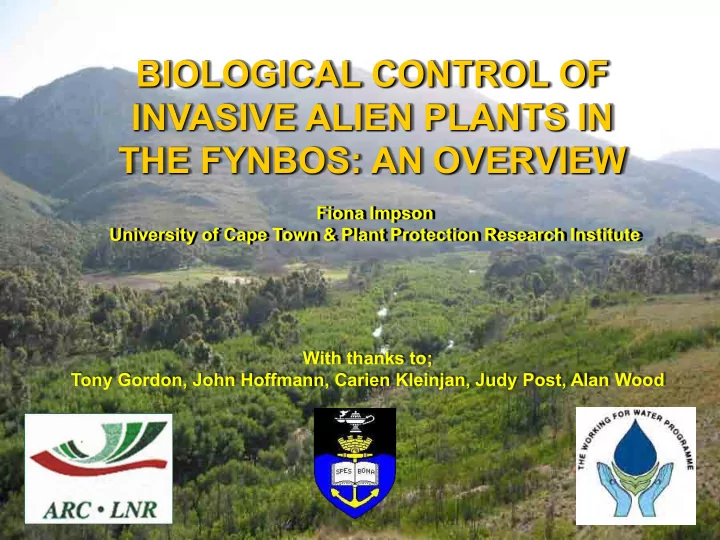

BIOLOGICAL CONTROL OF INVASIVE ALIEN PLANTS IN THE FYNBOS: AN OVERVIEW Fiona Impson University of Cape Town & Plant Protection Research Institute With thanks to; Tony Gordon, John Hoffmann, Carien Kleinjan, Judy Post, Alan Wood
• Species rich, makes up 80% of CFK • Despite diversity - few plants for food, shelter, fuel and timber • “Not even a tree to break the monotonous uniformity of the sandstone hills. I have never seen a much less interesting country.” Charles Darwin • Exotic trees first introduced into South Africa in late 1600s • Later (1800s) saw introduction of Australian Acacias, Eucalypts, Hakeas, Myrtle, Sesbania
Initially introduced into botanic & private gardens, many were later widely planted because of their uses
This can happen because plants are introduced without their natural enemies
How can we deal with invasive alien plants?
STEPS IN A BIOLOGICAL CONTROL PROGRAMME Study of the literature on the taxonomy and distribution of the weed and studies in the field to match plant populations in the native and introduced ranges. Investigate natural enemies of the plant and survey the native range for potential biological control agents
Where possible, study the biology, host-specificity and ecology of potential agents in the native range. Select potential biological control agents from the native range and apply for permission to import these into quarantine for further study.
Establish selected agents in quarantine facilities in the country of introduction. Screen in quarantine to detect any parasitoids and diseases which imported colonies of control agents may contain.
Check the identity and study the biology of introduced agents & carry out rigorous host-specificity tests on closely related and important plant species to ensure the safety of the biocontrol agent.
Application for permission to release in the country of introduction. Release of the biocontrol agent
Biological control of Fynbos weeds: Hypericum perforatum (1960) Past Sesbania punicea Hakea spp Present Acacia spp & Future Leptospermum laevigatum Water weeds
Hakea sericea : Australia, invades mtn Fynbos • One of the longest running biocontrol programmes in the fynbos, initiated in early 1960s • Inception not influenced by precedents in other countries • World first for using seed-feeders for a perennial weed
Hakea seed weevil, Erytenna consputa Released in 1970 Larvae destroy 86% of green developing fruits
Hakea seed moth, Carposina autologa Released in 1970 Larvae destroy up to 62.4% of seeds in mature fruits
The stem boring beetle, Aphanasium australe Released 2001 The flower feeding weevil, Dicomada rufa Released in 2006
Colletotrichum acutatum Targets above ground plant parts (adult trees + seedlings) Causes gummosis and die back above point of infection
Australian Acacia species: coastal & mtn fynbos – not restricted to fynbos Another long-standing programme – initiated 1970s Initially hampered by conflicts of interest delays (to 1982) Conflicts of interest continue to influence choice Seed-reducing agents recommended
10 of most invasive acacias currently have bc agents Acacia longifolia (1982/1985)) Acacia melanoxylon (1986) Acacia saligna (1987/2001) Paraserianthes lophantha (1989) Acacia cyclops (1991/2001) Acacia pycnantha (1992/2005) Acacia mearnsii (1994/2002) Acacia dealbata (1997) Acacia decurrens (2001) Acacia baileyana (2006) Acacia podalyriifolia (2008)
Biocontrol agents to reduce reproductive capacity have been the focus Insect gall-formers: 95% pod reduction overall
Insect gall formers Dasineura dielsi (2001) Avg 82% of flowers galled Avg 5 chambers per gall (up to 16) 32 galls per cluster Multivoltine Complete development within the gall Dispersal rapid
Insect gall formers Dasineura rubiformis Single gall Gall cluster (up to 36 galls) Gall chambers (up to 5/gall) Univoltine, Development in gall and soil, Dispersal relatively slow .
A. mearnsii seed rain (W Cape) New establishment of the midge 3500 & subsequent decline in seed rain 3000 2689 2500 Avg. seeds/m2 2000 1500 996 1000 500 225 113 12 3 0 2008 2009 2010 Year Effective suppression of seed rain at these sites
Pathogen: Rust fungus gall former Decreases pop’n densities & effects vegetative + reproductive growth
Seed-feeders: 1) Melanterius ventralis 2) Melanterius acaciae 4) Melanterius maculatus 3) Melanterius servulus 5) Melanterius compactus
The seed-feeding weevils Pupate within the soil • One generation per year (live 2yrs) • Dispersal +/- 2km/year • Damage levels variable Impacts of the weevil are affected by: • Site disturbance (clearing/fire) • Plant reproductive phenology (levels of annual pod production)
Leptospermum laevigatum : Australian, Coastal lowland fynbos
Biocontrol agents Leaf-mining moth, Aristaea thalassias Introduced in 1996 Impacts negligible Bud-galling midge, Dasineura sp. Introduced in 1994 Initial reports – very promising (98%) Can suffer high mortality Now damage highly variable Together both agents have highest impact on seedlings
How can biological control be implemented? • Not all agents need implementing – some disperse readily Identify potential biocontrol nursery sites (i.e. accessible, not targetted for clearing/burning) • Ensure the long-term protection of nursery sites (Fire breaks, inform landholders, demarcate to prevent clearing) • Request biocontrol agents via WfW Implementation or receive training in collecting & release procedures • Check for signs of establishment following release (not always immediate) • Once insect populations have built up, the nurseries become sites for collection & re-distribution
In conclusion: Biocontrol of perennial trees not without complication • plants fast growing, high seed-producers (ready competition with slow growing fynbos species) • conflicts of interest have substantially restricted control efforts (Acacias) • Implementation NB in terms of redistribution of agents • Selection & Protection of release sites is critical • Biocontrol is not a “quick-fix” and not always a stand alone remedy (especially using seed-feeders) Without biocontrol as part of an integrated management approach we have little chance of success against invasive plants
Recommend
More recommend